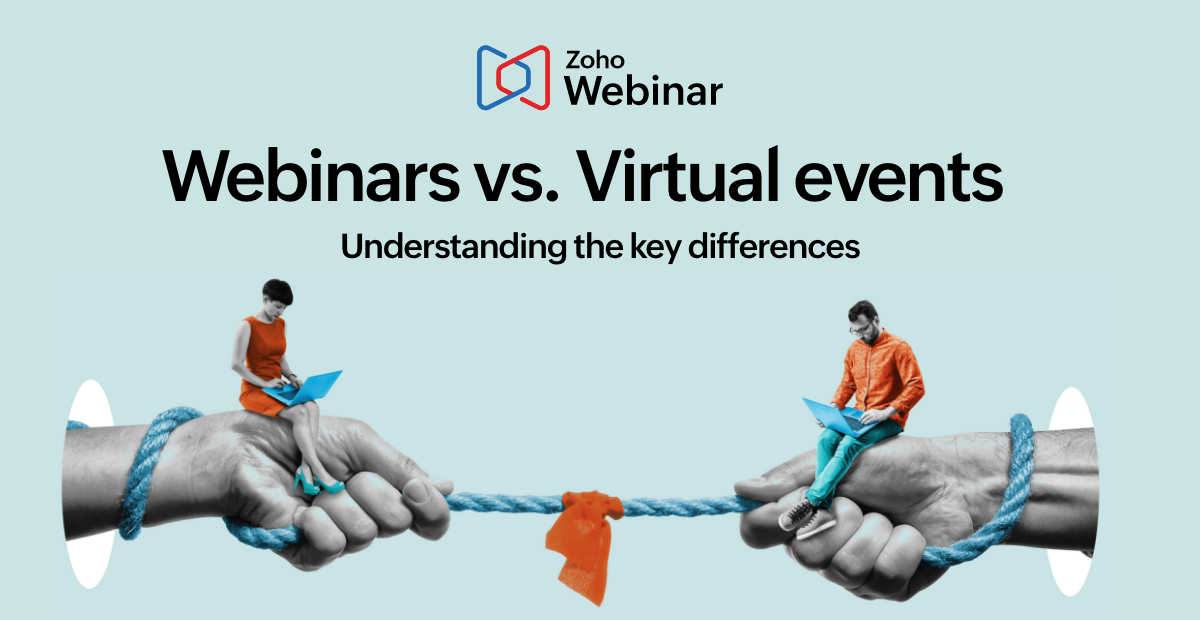- HOME
- Webinars vs. Virtual events: Understanding the key differences
Webinars vs. Virtual events: Understanding the key differences
- Last Updated : February 10, 2025
- 22 Views
- 2 Min Read
In the ever-evolving landscape of digital communication, terms like "virtual events" and "webinars" are frequently used, often interchangeably. However, they represent distinct concepts with specific features, purposes, and benefits. Here's a breakdown of what sets virtual events apart from webinars.

The difference between virtual events and webinars
Scope and scale
Virtual event: A virtual event is a broad term that encompasses a wide range of online activities, including conferences, trade shows, expos, summits, and more. These events are designed to simulate in-person experiences as closely as possible, often incorporating multiple educational sessions, keynote speakers, Q&A sessions, and networking opportunities.
Webinar: A webinar, short for "web-based seminar," is more focused in scope. Typically, it involves a single or recurring session with a specific topic, often led by one or a few presenters. Webinars can be designed for both small and large audiences, ranging from a handful of attendees to several thousand. The primary goal is to deliver educational content or conduct training sessions.
Interactivity
Virtual event: Virtual events prioritize interactivity and engagement. They often include features like live Q&A sessions, polls, chat, networking lounges, and interactive booths where participants can engage with sponsors or exhibitors. Attendees can interact with each other and with presenters in various ways, mimicking the networking opportunities found at in-person events.
Webinar: Webinars offer some level of interactivity, primarily through polls, Q&A sessions, and chat functions, but they're generally more structured. The format has the presenter delivering the content and the attendees asking questions or participating in polls as time permits. Zoho Webinar provides robust engagement features to interact with attendees throughout the webinar.
Technology and platforms
Virtual event: Hosting a virtual event often requires more sophisticated technology and a dedicated platform capable of handling multiple sessions, large audiences, and various interactive features to manage registration, content delivery, and attendee engagement.
Webinar: Webinars can be hosted on more focused platforms like Zoho Webinar. All you need is a computer with a compatible operating system, built-in or attached speakers and a microphone for audio transmission, a web camera for video transmission, and a supported web browser with a good internet connection.
Cost and resources
Virtual event: Virtual events generally require more resources and a bigger budget. Planning a virtual event is akin to organizing a physical conference, involving multiple stakeholders, marketing efforts, and technical support. The cost can vary significantly based on the scale and features required.
Webinar: Webinars are typically less resource-intensive and more cost-effective. They require fewer logistical efforts, with most of the focus on content creation and delivery. This makes webinars an attractive option for smaller organizations or those looking to conduct regular online sessions. Learn about the different types of webinars.
Wrapping up
Both virtual events and webinars serve important roles in the digital communication ecosystem, but they cater to different needs and objectives. Virtual events are ideal for gatherings that require extensive interaction, multiple sessions, and a broader scope. Webinars, on the other hand, are perfect for more focused, educational content delivered in a concise format.



